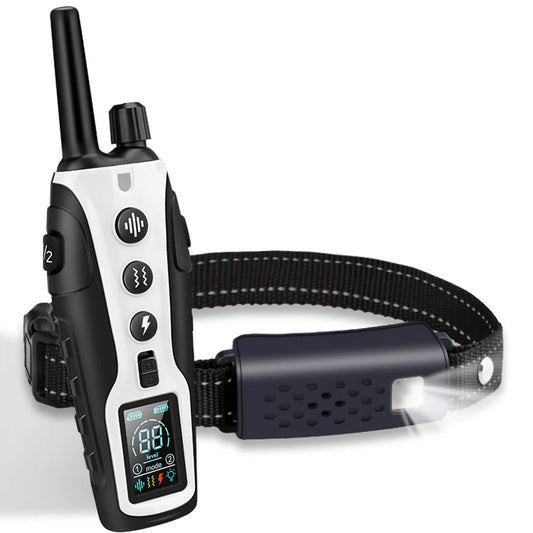How To Get a Dog To Stop Barking
If you're a dog owner, you know that barking is a natural behavior for dogs. However, excessive barking can be a problem, especially if it disturbs your neighbors or your own peace and quiet. One solution to this problem is an ultrasonic anti-barking device. But how effective is it? How To Get a Dog To Stop Barking
Ultrasonic anti-barking devices work by emitting high-frequency sound waves that are audible to dogs but not to humans. These sound waves are designed to be unpleasant to dogs, which can help to discourage excessive barking. The idea is that when the dog barks, the device picks up the sound and emits an ultrasonic sound that interrupts the barking behavior.
So, does it actually work? The effectiveness of ultrasonic anti-barking devices can vary depending on the dog and the situation. Some dogs may be more sensitive to the high-frequency sound waves, while others may be less affected. Additionally, some dogs may become habituated to the device over time and may eventually stop responding to it.
However, many dog owners report success with ultrasonic anti-barking devices. They find that the device can be a useful tool in reducing excessive barking, especially when used in conjunction with other training methods. For example, positive reinforcement training and desensitization can be effective in teaching your dog alternative behaviors to barking.
It's important to note that ultrasonic anti-barking devices should be used in moderation and as part of a comprehensive training plan. It's not a magic solution, and it should not be used as a substitute for addressing the root causes of your dog's barking behavior. Additionally, if your dog's barking is a symptom of an underlying medical or behavioral issue, an ultrasonic anti-barking device may not be effective.
Understanding the reasons behind excessive barking: To effectively stop your dog from barking, it's important to understand why they are barking in the first place. Is it due to anxiety, boredom, or territorial behavior? Identifying the root cause can help you choose the best approach to address the problem.
Excessive barking can be a frustrating issue for dog owners to deal with. It's important to understand the reasons behind this behavior in order to effectively address it. Here's a guide on how to stop your dog from barking and understand the reasons behind their behavior.
- Understanding the reasons behind excessive barking: As mentioned earlier, identifying the root cause of your dog's barking is crucial in finding an effective solution. Common reasons include separation anxiety, boredom, territorial behavior, or a lack of exercise.
- Positive reinforcement training: Positive reinforcement training can be an effective way to teach your dog to stop barking. This involves rewarding your dog for good behavior and ignoring or redirecting their attention away from the behavior you don't want.
- Desensitization: Desensitization involves gradually exposing your dog to the stimuli that cause them to bark, such as other dogs or people walking by. Over time, your dog should become desensitized to these triggers and stop barking excessively.
- Choosing the right device: Ultrasonic anti-barking devices can be effective in stopping excessive barking. However, it's important to choose the right device for your dog's size and barking habits.
- Monitoring your dog's response: It's important to monitor your dog's response to any training or devices you use. If the approach is not effective or causes your dog distress, it may be necessary to try a different approach.
Remember, addressing excessive barking can take time and patience. With the right approach and consistent training, you can help your dog overcome this behavior and enjoy a more peaceful environment.
Training techniques for barking: While an ultrasonic anti-barking device can be helpful, there are several training techniques you can use to help your dog learn to stop barking. These include positive reinforcement training, desensitization, and counter-conditioning.
Training Techniques for Barking: Effective Ways to Stop Your Dog from Barking
Barking is a natural behavior for dogs, but excessive barking can become a nuisance for both you and your neighbors. Fortunately, there are several training techniques you can use to help your dog learn to stop barking. In this article, we will explore some effective methods for addressing barking behavior in dogs.
Positive Reinforcement Training: One of the most effective training techniques for barking is positive reinforcement training. This involves rewarding your dog for good behavior and ignoring or redirecting their barking. When your dog barks excessively, redirect their attention to a toy or treat, and praise them when they stop barking. Consistency is key, so be sure to reward your dog every time they exhibit good behavior.
Desensitization: Another technique for addressing barking behavior is desensitization. This involves gradually exposing your dog to the triggers that cause them to bark and teaching them to remain calm in those situations. For example, if your dog barks at other dogs while on walks, start by introducing them to dogs from a distance and gradually decreasing the distance as they become more comfortable.
Counter-Conditioning: Counter-conditioning involves changing your dog's emotional response to the trigger that causes them to bark. For example, if your dog barks when visitors come to the door, start by teaching them to go to a designated spot and rewarding them for staying calm. Gradually increase the duration of time they remain calm in that spot while visitors come and go.
Ultrasonic Anti-Barking Devices: Another option for addressing barking behavior is using an ultrasonic anti-barking device. These devices emit a high-pitched sound that is unpleasant to dogs, but not harmful. When your dog barks, the device emits the sound, which can help to interrupt their barking and redirect their attention.
Professional Training: If your dog's barking behavior is severe or persistent, it may be necessary to seek professional training. A professional dog trainer can assess your dog's behavior and develop a personalized training plan to address the problem.
The importance of consistency: Consistency is key when it comes to stopping dog barking. Using an ultrasonic anti-barking device or implementing training techniques sporadically will not be as effective as consistently using the same approach.
When it comes to stopping your dog from barking excessively, consistency is key. It's important to understand that barking is a natural behavior for dogs, but excessive barking can become a nuisance for you and your neighbors. In order to effectively address this behavior, it's important to be consistent with your approach.
One effective way to stop dog barking is by using an ultrasonic anti-barking device. These devices emit a high-pitched sound that is unpleasant to dogs and can deter them from barking. However, it's important to use the device consistently and appropriately in order for it to be effective. This means positioning the device in the right location and using it every time your dog barks.
Training techniques can also be helpful in reducing excessive barking. Positive reinforcement training involves rewarding your dog for good behavior, such as remaining quiet. This can be done through treats, praise, and affection. Desensitization involves gradually exposing your dog to the triggers that cause them to bark, such as other dogs or loud noises, in a controlled and positive environment. Counter-conditioning involves replacing the negative association your dog has with a trigger with a positive one, such as rewarding them for remaining quiet when the trigger is present.
Whatever approach you choose, consistency is key. Inconsistently using an anti-barking device or training technique will not be as effective as consistently using the same approach. Dogs thrive on routine and consistency, and by using the same approach every time your dog barks, they will begin to learn what is expected of them.
In addition to being consistent with your approach, it's also important to be patient and persistent. Stopping excessive barking is not a quick fix and may take time and effort on your part. However, with consistency and patience, you can successfully teach your dog to stop barking excessively and improve the quality of life for you and your dog.
How To Get a Dog To Stop Barking
Excessive barking can be a frustrating problem for pet owners, and it can also be a nuisance to neighbors and other members of the community. While there are many strategies and tools that can be used to address this issue, sometimes seeking professional help is necessary to achieve lasting results.
Professional dog trainers and behaviorists are experts in understanding the reasons behind a dog's barking and can provide personalized advice and guidance to address the problem. They have the knowledge and experience to assess the dog's behavior and recommend an appropriate course of action.
When seeking professional help, it's important to choose a trainer or behaviorist who has experience working with barking dogs. Look for someone who uses positive reinforcement techniques and has a track record of success in addressing similar issues.
During your initial consultation with a professional, they will likely ask you questions about your dog's behavior and the context in which the barking occurs. They may also observe your dog in different situations to get a better understanding of the problem.
Based on their assessment, the professional may recommend a variety of strategies to address the barking behavior. This may include positive reinforcement training, desensitization, counter-conditioning, or a combination of techniques.
In some cases, medication may also be recommended to help address underlying anxiety or fear issues that may be contributing to the barking.
It's important to note that addressing barking behavior is a process that requires patience and consistency. You'll need to work closely with the professional and follow their recommendations closely in order to see results.
User Real-life success stories of using anti-barking devices on neighbor's dogs or your dog.
Once upon a time, there was a family who lived in a peaceful neighborhood. However, their tranquility was disrupted by the constant barking of their neighbor's dog. It was a big, aggressive dog that would bark at anything and everything, day and night.
The family tried talking to their neighbor about the barking dog, but nothing changed. They also tried using earplugs to sleep at night, but the barking was too loud and persistent. They were at their wits' end and didn't know what to do.
One day, a friend suggested they try an anti-barking device. Skeptical at first, the family decided to give it a try. They researched different types of devices and settled on an ultrasonic bark control device. The device emits a high-frequency sound that is unpleasant to dogs but inaudible to humans.
The family set up the device in their backyard, pointing it towards their neighbor's fence. The first night, the barking started as usual, but then something miraculous happened. The dog started barking, but suddenly stopped mid-bark and retreated. The barking stopped completely.
The family was amazed and relieved. Finally, they could enjoy peace and quiet in their home. They were also happy that they didn't have to confront their neighbor, which could have caused tension between them.
A few weeks later, the family noticed that the dog had stopped barking altogether, even when the anti-barking device wasn't turned on. They ran into their neighbor and asked if everything was okay with their dog. To their surprise, the neighbor apologized for the barking and explained that they had also tried an anti-barking device but didn't have much success. However, they noticed that when the family had set up their device, it had a positive effect on their dog's barking behavior as well.
From that day forward, the two families had a better relationship, and the neighborhood became a more peaceful place. The family was grateful for the success of the anti-barking device and how it had not only helped their situation but also their neighbor's. They recommended the device to other families in the area and continued to enjoy their peaceful home without the constant barking of their neighbor's dog.

Also, you can see our social media:




